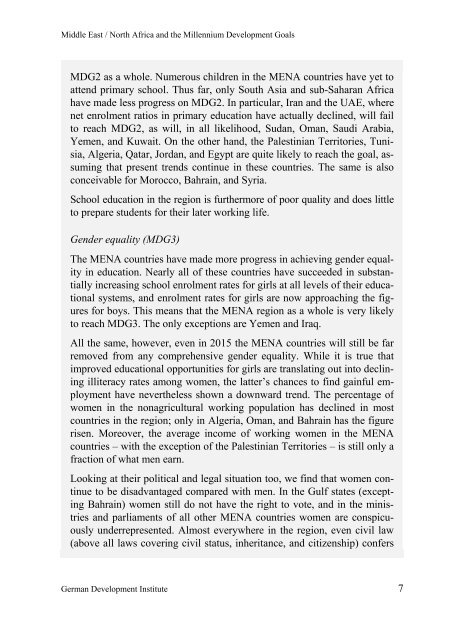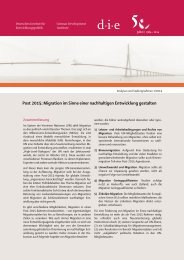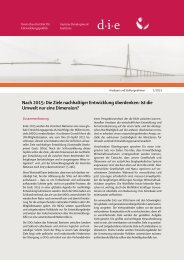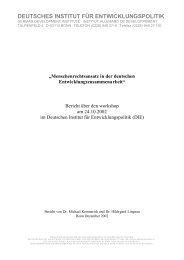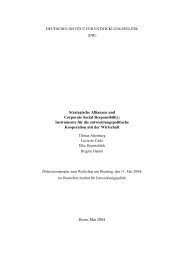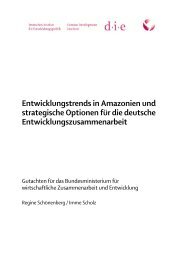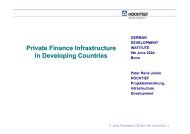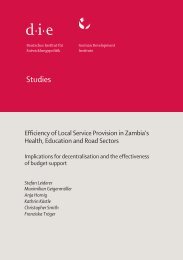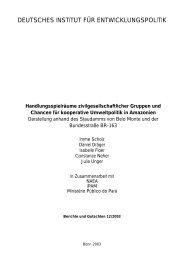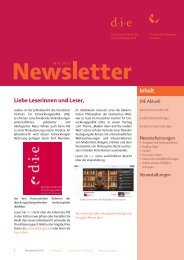Middle East / North Africa and the Millennium Development Goals ...
Middle East / North Africa and the Millennium Development Goals ...
Middle East / North Africa and the Millennium Development Goals ...
Create successful ePaper yourself
Turn your PDF publications into a flip-book with our unique Google optimized e-Paper software.
<strong>Middle</strong> <strong>East</strong> / <strong>North</strong> <strong>Africa</strong> <strong>and</strong> <strong>the</strong> <strong>Millennium</strong> <strong>Development</strong> <strong>Goals</strong><br />
MDG2 as a whole. Numerous children in <strong>the</strong> MENA countries have yet to<br />
attend primary school. Thus far, only South Asia <strong>and</strong> sub-Saharan <strong>Africa</strong><br />
have made less progress on MDG2. In particular, Iran <strong>and</strong> <strong>the</strong> UAE, where<br />
net enrolment ratios in primary education have actually declined, will fail<br />
to reach MDG2, as will, in all likelihood, Sudan, Oman, Saudi Arabia,<br />
Yemen, <strong>and</strong> Kuwait. On <strong>the</strong> o<strong>the</strong>r h<strong>and</strong>, <strong>the</strong> Palestinian Territories, Tunisia,<br />
Algeria, Qatar, Jordan, <strong>and</strong> Egypt are quite likely to reach <strong>the</strong> goal, assuming<br />
that present trends continue in <strong>the</strong>se countries. The same is also<br />
conceivable for Morocco, Bahrain, <strong>and</strong> Syria.<br />
School education in <strong>the</strong> region is fur<strong>the</strong>rmore of poor quality <strong>and</strong> does little<br />
to prepare students for <strong>the</strong>ir later working life.<br />
Gender equality (MDG3)<br />
The MENA countries have made more progress in achieving gender equality<br />
in education. Nearly all of <strong>the</strong>se countries have succeeded in substantially<br />
increasing school enrolment rates for girls at all levels of <strong>the</strong>ir educational<br />
systems, <strong>and</strong> enrolment rates for girls are now approaching <strong>the</strong> figures<br />
for boys. This means that <strong>the</strong> MENA region as a whole is very likely<br />
to reach MDG3. The only exceptions are Yemen <strong>and</strong> Iraq.<br />
All <strong>the</strong> same, however, even in 2015 <strong>the</strong> MENA countries will still be far<br />
removed from any comprehensive gender equality. While it is true that<br />
improved educational opportunities for girls are translating out into declining<br />
illiteracy rates among women, <strong>the</strong> latter’s chances to find gainful employment<br />
have never<strong>the</strong>less shown a downward trend. The percentage of<br />
women in <strong>the</strong> nonagricultural working population has declined in most<br />
countries in <strong>the</strong> region; only in Algeria, Oman, <strong>and</strong> Bahrain has <strong>the</strong> figure<br />
risen. Moreover, <strong>the</strong> average income of working women in <strong>the</strong> MENA<br />
countries – with <strong>the</strong> exception of <strong>the</strong> Palestinian Territories – is still only a<br />
fraction of what men earn.<br />
Looking at <strong>the</strong>ir political <strong>and</strong> legal situation too, we find that women continue<br />
to be disadvantaged compared with men. In <strong>the</strong> Gulf states (excepting<br />
Bahrain) women still do not have <strong>the</strong> right to vote, <strong>and</strong> in <strong>the</strong> ministries<br />
<strong>and</strong> parliaments of all o<strong>the</strong>r MENA countries women are conspicuously<br />
underrepresented. Almost everywhere in <strong>the</strong> region, even civil law<br />
(above all laws covering civil status, inheritance, <strong>and</strong> citizenship) confers<br />
German <strong>Development</strong> Institute 7


